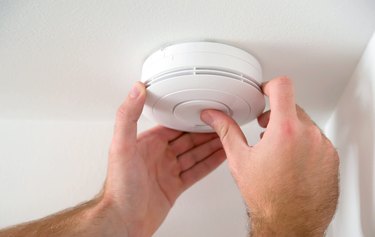
You can appreciate your smoke detector's sensitivity — it might save your life someday, after all — while still being jaw-clenchingly irritated every time it goes off for no good reason. The presence of steam is sometimes enough to set off a smoke detector, so a relaxing shower could be interrupted by the shrill screech of your smoke detector at any moment. It's not always possible to prevent steam-related false alarms, but there are a few strategies to try.
Tip
Steam from cooking, showering or even very humid weather can set off a smoke detector. Relocating or upgrading the unit is the best way to stop false alarms.
Video of the Day
Why Steam Triggers Smoke Detectors
Smoke detectors commonly use one of two detection methods. In a photoelectric smoke detector, a beam of light is projected across an empty chamber. When smoke enters the chamber, it deflects the beam so light is projected onto a sensor that triggers the alarm. In an ionization smoke detector, a tiny amount of radioactive material and two charged electrodes create a steady current of electricity. Smoke particles that enter the area disrupt the current, which triggers the alarm.
Video of the Day
Photoelectric smoke detectors are better at detecting active flames, while ionization smoke detectors are better at detecting slow, smoldering fires. Because the two detection technologies have these slightly different benefits, the National Fire Protection Association recommends that every home have both. Conveniently, you can buy dual-sensing smoke alarms that combine both photoelectric and ionization detection.
Both kinds of technologies are pretty good at detecting the presence of heavy smoke particles, but they aren't necessarily great at distinguishing between smoke and other "heavy" air, like steam. Essentially, your alarm will tell you whenever it detects any change in the air, whether that's dangerous smoke or harmless steam from a long shower. Even very humid weather can sometimes trigger a false alarm from a smoke detector.
Preventing False Alarms
Most of the smoke detectors made for home use are pretty basic, so it's unlikely you're going to be able to modify an existing unit in any way to make it less sensitive to steam. Of course, attempting to modify or disable your alarm could affect its ability to detect real smoke, so don't tinker with it.
You have a few long-term options for dealing with a smoke detector that's set off by steam:
- First, turn on dehumidifiers before introducing any steam into the air; this may prevent some false alarms.
- Second, you may want to take down and reinstall the smoke detector a few feet farther away from the bathroom, stove or other areas where steam is routinely produced. You probably don't want to move it too far from its original location, especially if it's in the kitchen. (Depending on whether it's a battery-operated or hardwired smoke detector, it may be more difficult to relocate the unit.)
- The final option is to upgrade to a smarter system. Nest Protect is a dual smoke and carbon monoxide detector that uses a humidity sensor to differentiate between smoke and steam, preventing false alarms. It's the first one of its kind, but as technology advances, consumers may eventually have more choices when shopping for smart smoke detectors.
Steam and Heat Detectors
Some homes may have heat detectors installed in addition to smoke detectors. Heat detectors are sometimes installed in garages, sheds, attics and areas where smoke detectors are frequently set off by false alarms. The big difference between smoke detectors and heat detectors is that heat detectors are set off by rapid temperature increases. They won't detect smoldering fire or smoke. The steam from a shower or humid summer air generally won't be hot enough to trigger a heat detector.